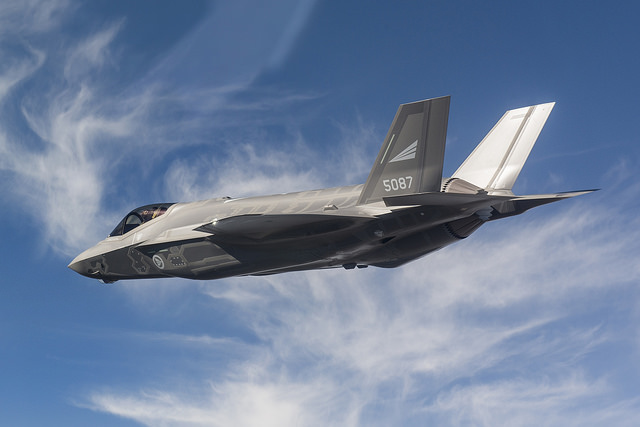
Within days, Australians will get to see the first of the RAAF’s new Joint Strike Fighters—just months after the jet’s noisiest critics told an inquiry it was a ‘jackass of all trades and masterful of none’. Two members of the Air Power Australia group went on to tell the Senate committee the aircraft was ‘a broken and obsolete design, unsuitable for modern combat’. The reality, say Australian fighter pilots and senior members of the ADF with intimate knowledge of the JSF’s capability, is vastly different.
RAAF chief, Air Marshal Leo Davies, tells The Strategist that while the JSF, now officially the F-35 Lightning ll, has had its problems, it could never have got to the stage it’s reached if its critics were right. ‘It has flown over 70,000 flight hours, more than 200 jets are flying, the United States Marine Corps has reached Initial Operational Capability (IOC), the US Air Force has gone IOC, the US Navy is about to go IOC,’ says Air Marshal Davies. ‘It’s incongruous to me to hear people suggest it doesn’t work. That can’t happen. ‘Is it at its peak war fighting design and software load at the moment? No, it has got one more step to come.’
The JSF remains a work in progress, but by the time the RAAF buys its aircraft, the next design and software upgrade should be complete and the F-35s will be significantly more capable than Hornets or Super Hornets.
Air Marshal Davies says the results of the intense Red Flag air combat exercise in the US ‘absolutely cement our view that this is the right aeroplane for Australia.’ US media is talking about a 15:1 kill ratio in favour of the F-35 against older generation fighters in the exercise in which RAAF air crews took part. (Though some commentators have raised questions about the significance of that figure.)The officer responsible for the Australian end of the US-led multinational JSF program says the aircraft will revolutionise the way the nation fights wars far into the future.
The head of the RAAF’s JSF Capability and Sustainment Group, Air Vice Marshal Leigh Gordon, says four factors give the F35 its ‘fifth generation’ edge—stealth, sensors, fusion and data sharing.
‘Two factors stand out. One is the phenomenally powerful cutting edge radar. The other is the distributer aperture system, or DAS, cameras which give the pilot a 360 degree infrared view of the world. The third element is the way all of that information is fused together to give the pilot unparalleled situational awareness.’
A fourth element is the JSF’s ability to quickly share the vast amount of information it gathers with air, land and naval forces. ‘It will allow us to operate in the high threat environments we will need to operate in if we end up in a conflict.’
Air Vice Marshal Gordon is confident that the first of the 72 JSFs on order for the RAAF will be based in Australia by December 2018 and the first operational squadron and a training squadron will reach IOC by December 2020. Three squadrons will be fully combat ready in 2023.
Group Captain Glen Beck has been a fighter pilot all his adult life and is now director of the RAAF’s Air Combat Transition Office. He served in Iraq in 2003 as a flight commander and he’s trained many of the RAAF’s top pilots. The aim, he says, isn’t just to see aircraft delivered and hangers built for them but to get to a mature and self-sustaining system with fully trained pilots ready for operations. ‘With F-35 we are on a massive learning curve.’ He says RAAF specialists deeply embedded in the program in the US are well placed to identify any problems with the JSF. Two RAAF pilots are in the US instructing international pilots to fly the JSF and three others are training there to become instructors.
‘When you compare JSF to other options, when you look out past the 2030s, looking at the global strategic situation and where technology’s going, it is the standout choice as the best solution to Australia’s air power needs. The guys love how it flies. It’s very easy to operate.’
The JSF is designed for what the pilots call ‘BVR’—beyond visual range—combat but the Australian pilots say it can dogfight as well.
Group Captain Beck says it’s all about what the fighter pilots call the ‘kill chain’. ‘Do I have more options than the bad guys to stay alive longer and then do I have more options to fight than the bad guys? I don’t care if they find me if they can’t track me and target me. ‘If they do find me, then to track me is a different problem again. But the F-35 has fantastic sensors. I will know they are targeting me and I’m not going to do nothing if I think I’m being shot at.’
Getting the pair of highly advanced, ‘fifth generation’ jets to the Avalon Air Show will itself be a comprehensive demonstration of aviation logistics. They’ll be flown to Australia by Aussie pilots and frequently topped up along the way by a RAAF KC-30 air-to-air refuelling tanker.
Another officer with an intense interest in ensuring that the JSF works is Army chief Lieutenant General Angus Campbell. He rejects suggestions the F-35 will not be able to provide troops on the ground with effective air support. ‘The JSF is an extremely advanced fighter which has extraordinary and possibly unparalleled capacities in information networking which we’ve not seen in the ADF before,’ says Lieutenant General Campbell.
‘Every soldier on every battlefield through modern history will want, or pray for, control of the air above him or her. The F-35 gives our soldiers the greatest confidence that they will have air control above them. I’m delighted we’re getting it. Only those who don’t have air control above them know the true horror of that environment and I would not want that for Australian soldiers.’

